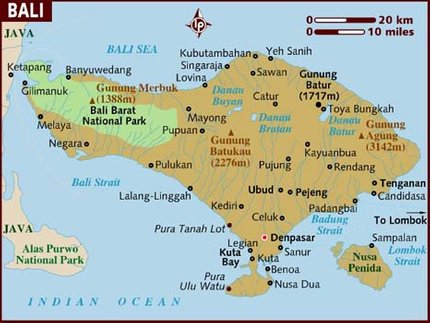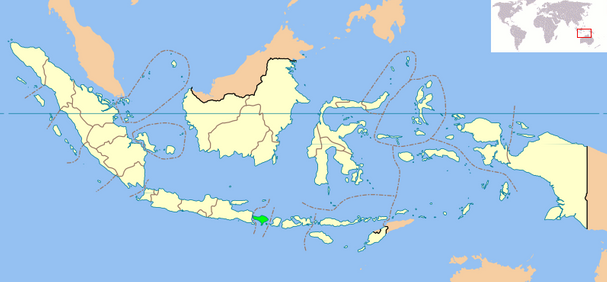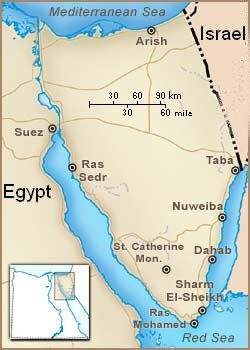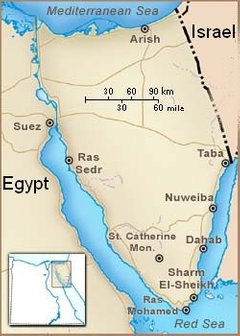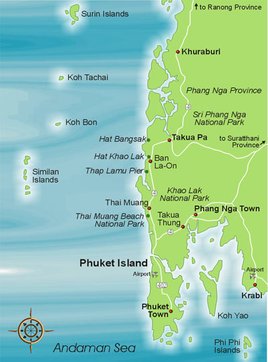ScubaTimo
Pagina over duiken en reizen in binnen- en buitenland
Website about scuba diving and traveling around the globe
Bali, Indonesia
Bali is a province in the country of Indonesia. The island is located in the westernmost end of the Lesser Sunda Islands, lying between Java to the west and Lombok to the east. It is one of the country's 33 provinces with the provincial capital at Denpasar towards the south of the island. The province covers a few small neighbouring islands as well as the isle of Bali.
With a population recorded as 3,891,428 in the 2010 census, the island is home to most of Indonesia's Hindu minority. In the 2000 census about 92.29% of Bali's population adhered to Balinese Hinduism while most of the remainder follow Islam. It is also the largest tourist destination in the country and is renowned for its highly developed arts, including traditional and modern dance, sculpture, painting, leather, metalworking, and music. Bali, a tourist haven for decades, has seen a further surge in tourist numbers in recent years.
Geography
The island of Bali lies 3.2 km (2 mi) east of Java, and is approximately 8 degrees south of the equator. Bali and Java are separated by the BaliStrait. East to west, the island is approximately 153 km (95 mi) wide and spans approximately 112 km (69 mi) north to south; its land area is 5,632 km².
Bali's central mountains include several peaks over 3,000 metres in elevation. The highest is MountAgung (3,031 m), known as the "mother mountain" which is an active volcano. Mountains range from centre to the eastern side, with MountAgung the easternmost peak. Bali's volcanic nature has contributed to its exceptional fertility and its tall mountain ranges provide the high rainfall that supports the highly productive agriculture sector. South of the mountains is a broad, steadily descending area where most of Bali's large rice crop is grown. The northern side of the mountains slopes more steeply to the sea and is the main coffee producing area of the island, along with rice, vegetables and cattle. The longest river, AyungRiver, flows approximately 75 km.
The island is surrounded by coral reefs. Beaches in the south tend to have white sand while those in the north and west have black sand. Bali has no major waterways, although the Ho River is navigable by small sampan boats. Black sand beaches between Pasut and Klatingdukuh are being developed for tourism, but apart from the seaside temple of Tanah Lot, they are not yet used for significant tourism.
The largest city is the provincial capital, Denpasar, near the southern coast. Its population is around 491,500 (2002). Bali's second-largest city is the old colonial capital, Singaraja, which is located on the north coast and is home to around 100,000 people. Other important cities include the beach resort, Kuta, which is practically part of Denpasar's urban area, and Ubud, situated at the north of Denpasar, is the island's cultural centre.
Three small islands lie to the immediate south east and all are administratively part of the Klungkung regency of Bali: Nusa Penida, Nusa Lembongan and Nusa Ceningan. These islands are separated from Bali by the BadungStrait.
To the east, the LombokStrait separates Bali from Lombok and marks the biogeographical division between the fauna of the Indomalayan ecozone and the distinctly different fauna of Australasia. The transition is known as the Wallace Line, named after Alfred Russel Wallace, who first proposed a transition zone between these two major biomes. When sea levels dropped during the Pleistocene ice age, Bali was connected to Java and Sumatra and to the mainland of Asia and shared the Asian fauna, but the deep water of the LombokStrait continued to keep Lombok and the Lesser Sunda archipelago isolated.
Tourism
The tourism industry is primarily focused in the south, while significant in the other parts of the island as well. The main tourist locations are the town of Kuta (with its beach), and its outer suburbs of Legian and Seminyak (which were once independent townships), the east coast town of Sanur (once the only tourist hub), in the center of the island Ubud, to the south of the Ngurah Rai International Airport, Jimbaran, and the newer development of Nusa Dua and Pecatu.
The American government lifted its travel warnings in 2008. The Australian government last issued an advice on Friday, 4 May 2012. The overall level of the advice was lowered to 'Exercise a high degree of caution'.
An offshoot of tourism is the growing real estate industry. Bali real estate has been rapidly developing in the main tourist areas of Kuta, Legian, Seminyak and Oberoi. Most recently, high-end 5 star projects are under development on the Bukit peninsula, on the south side of the island. Million dollar villas are being developed along the cliff sides of south Bali, commanding panoramic ocean views. Foreign and domestic (many Jakarta individuals and companies are fairly active) investment into other areas of the island also continues to grow. Land prices, despite the worldwide economic crisis, have remained stable.
In the last half of 2008, Indonesia's currency had dropped approximately 30% against the US dollar, providing many overseas visitors value for their currencies. Visitor arrivals for 2009 were forecast to drop 8% (which would be higher than 2007 levels), due to the worldwide economic crisis which has also affected the global tourist industry, but not due to any travel warnings.
Bali's tourism economy survived the terrorist bombings of 2002 and 2005, and the tourism industry has in fact slowly recovered and surpassed its pre-terrorist bombing levels; the longterm trend has been a steady increase of visitor arrivals. At 2010, Bali received 2.57 million foreign tourists. It is surpassed the target of 2.0–2.3 million tourists. The average occupancy of starred hotels achieved 65 percent (last year 60.8 percent), so still capable for accommodates tourists for next some years without any addition of new rooms/hotels, although at the peak season some of them are fully booked.
Bali received the BestIsland award from Travel and Leisure in 2010. The award was presented in the show "World's Best Awards 2010" in New York, on 21 July. Hotel Four Seasons Resort Bali at Jimbaran also received an award in the category of "World Best Hotel Spas in Asia 2010". The award was based on a survey of travel magazine Travel and Leisure readers between 15 December 2009 through 31 March 2010, and was judged on several criteria. Thermes Marins Bali, Ayana Resort and Spa, (formerly The Ritz-Carlton) got score 95.6 scored out of a maximum 100 of satisfaction index with spa facilities and services as No. 1 Spa in the world by Conde Naste's Traveller Magazine for 2010 by their readers poll. The island of Bali won because of its attractive surroundings (both mountain and coastal areas), diverse tourist attractions, excellent international and local restaurants, and the friendliness of the local people. According to BBC Travel released in 2011, Bali is one of the World's BestIslands, rank in second after Greece.
On August 2010, the film version of Eat, Pray, Love (EPL), which starred Julia Roberts, was released in theaters. The movie was based on Elizabeth Gilbert's best-selling memoir of the same name. It took place at Ubud and Padang-PadangBeach at Bali. The 2006 book, which spent 57 weeks at the No. 1 spot on the New York Times paperback nonfiction best-seller list, has already fueled a boom in EPL tourism in Ubud, the hill town and cultural and tourist center that was the focus of Gilbert's quest for balance through traditional spirituality and healing that leads to love. Newly launched packages by luxury resorts and spas like Ubud Hanging Gardens and the cliff-top Ayana promise to recreate Gilbert's four transformative months on Bali in a few passing days with yoga classes, drawn-out beach dinners, and massage therapy. Other tours built around the book focus on curative group gatherings and self-discovery of the kind Gilbert had. EPL helped boost Bali’s tourist numbers, together with the stable security situation on the island. Bali had 2.5 million visitors in 2010, exceeding their target of 2.3 million. That figure was also an improvement from 2009’s 2.2 million and 2008’s 1.96 million visitors. The Tourism Office admitted that they had done nothing to maximize the opportunity to promote Bali and surrender to the filmmakers to promote.
Since 2011, China has displaced Japan as the second-largest supplier of tourists to Bali, while Australia still tops the list. China tourists increased by 17 percent from last year due to the impact of ACFTA and new direct flights to Bali. In January 2012, Chinese tourists year on year (yoy) increased by 222.18 percent compared to January 2011, while Japanese tourists declined by 23.54 percent yoy.
Dahab, Egypt
Dahab is a small town situated on the southeast coast of the Sinai Peninsula in Egypt. Formerly a Bedouin fishing village, located approximately 80 km (50 miles) northeast of Sharm el-Sheikh, Dahab is considered to be one of the Sinai's most treasured diving destinations. Following the Six Day War, the town was occupied by Israel and is known in Hebrew as Di-Zahav, a place mentioned in the Bible as one of the stations for the Israelites during the Exodus from Egypt. The Sinai Peninsula was restored to Egyptian rule in the Israel-Egypt Peace Treaty in 1982. The arrival of international hotel chains and the establishment of other ancillary facilities has since made the town a popular destination with tourists. Dahab is served by Sharm el-Sheikh International Airport. Masbat (within Dahab) is a popular diving destination, meaning that there are many (50+) dive centers located within Dahab.
Tourism
Dahab enjoys large numbers of tourists. It is world-renowned for its windsurfing. Reliable winds provide superb flat-water conditions inside Dahab's sand spit. Further away from shore, wavy conditions couple with strong winds to provide formidable conditions for keen windsurfers. SCUBA diving and snorkelling are also popular activities with many reefs immediately adjacent to waterfront hotels. The nearby Blue Hole-Which is nicknamed as "The World's Most Dangerous Diving Site"- and Canyon are internationally famous dive spots. Land based activities include camel, horse, jeep and quad bike trips. Mount Sinai is a two hours drive, with Saint Catherine's Monastery being a popular tourist destination.
Historically, most visitors to Dahab have been backpackers travelling independently and staying in hostels in the Masbet area. In recent years, development of hotels in the Medina area has facilitated the arrival of a wider range of tourists, many of whom visit Dahab specifically to partake in the windsurfing, diving and other activities.
The word Dahab is Arabic for gold and is possibly a reference to the geographic locality; gold washed down from the desert mountains may have accumulated on the alluvial flood plain where the town was built. The name may also be a reference to the colour of the sands to the south of the town itself. Some locals attribute the name to the colour of the sky, just after sunset.
One local story concerning the town's name is that it stems from the floods that wash through the town every five or six years. Larger than average seasonal storms in the mountains cause a great rush of water to surge down to the sea, dragging with it great amounts of sand. During this time, the town is cut in two by the flood, and the bay is stirred up and the sands turn it a golden yellow. It typically lasts a few days, and has caused damage and loss of life in the past as people were unaware of the sudden onset and the force the water moves at. Nowadays locals are ready when they see the clouds over the mountains, and anyone lucky enough to witness it will remember it for a long time.
Unfortunately, much of the coral in the reefs just offshore are slowly disappearing, due to inexperienced divers being taken out in big numbers. Another big problem is that in Masbat, local restaurants are dumping sand and rock in the sea to extend out into the shore, again, causing disruption to local coral reefs.
With its pleasant weather all year round, Dahab gained its worldwide fame. Yet, weather in summer is hot and during winter it is much milder especially during nights. Dahab has a very dry climate and rain is rare, even during the winter months.
This vacation is listed with Asia, because actaully the Suez Canal is the border between Africa and Asia. One could think since this is Egypt it is Africa, but actually this is Asia.
Taba, Egypt
Taba (Arabic: طابا) is a small Egyptian town near the northern tip of the Gulf of Aqaba. Taba is the location of Egypt's busiest border crossing with neighboring Israel. Little more than a bus depot and a luxury hotel (complete with casino), Taba is a frequent vacation spot for Egyptians and tourists, especially those from Israel on their way to others destinations in Egypt or as a weekend getaway. It is the northernmost resort of Egypt's Red Sea Riviera.
Taba was the last portion of Sinai to be returned to Egypt under the terms of the 1979 Israel-Egypt Peace Treaty.
Taba was on the Egyptian side of the armistice line agreed to in 1949, and returned to Egypt when Israel withdrew from the Sinai in 1957. However, when Israel reoccupied the Sinai after the Six-Day War (1967), a 400-room hotel was built at Taba. When Egypt and Israel were negotiating the exact position of the border in preparation for the 1979 peace treaty, Israel claimed that Taba had been on the Ottoman side of a border agreed between the Ottomans and British Egypt in 1906 and had, therefore, been in error in its two previous agreements. After a long dispute, the issue was submitted to an international commission composed of one Israeli, one Egyptian, and three outsiders. In 1988, the commission ruled in Egypt's favor, and Israel returned Taba to Egypt later that year.
As part of this subsequent agreement, travellers are permitted to cross from Israel at the Eilat - Taba border crossing, and visit the "Aqaba Coast Area of Sinai", ( stretching from Taba down to Sharm el Sheikh, and including Nuweiba, St Catherine and Dahab ), visa-free for up to 14 days, making Taba a popular tourist destination. The resort community of Taba Heights is located some 20 km south of Taba. It features several large hotels, including The Hyatt Regency, Marriott, Sofitel and Intercontinental. It is also a significant diving area where many people come to either free dive, scuba dive or learn to dive via the many PADI courses on offer. Other recreation facilities include a new desert style golf course.
On October 7, 2004, the Hilton Taba was hit by a bomb that killed 34 people (BBC), including Israeli vacationers. Twenty-four days later, an inquiry by the Egyptian Interior Ministry into the bombings concluded that the perpetrators received no external help but were aided by Bedouins on the peninsula. (Reuters) (BBC)
This vacation is listed with Asia, because actaully the Suez Canal is the border between Africa and Asia. One could think since this is Egypt it is Africa, but actually this is Asia.
Thailand, Khao Lak
Thailand, formerly Siam, and officially the Kingdom of Thailand, is an independent country that lies in the heart of Southeast Asia. It is bordered to the north by Burma and Laos, to the east by Laos and Cambodia, to the south by the Gulf of Thailand and Malaysia, and to the west by the Andaman Sea and the southern extremity of Burma. Its maritime boundaries are shared with Vietnam in the Gulf of Thailand to the southeast. Thailand also shares maritime boundaries with Indonesia and India in the Andaman Sea to the southwest.
The country is a kingdom, a constitutional monarchy with King Bhumibol Adulyadej, the ninth king of the House of Chakri, who has reigned since 1946, making him the world's longest-serving current head of state and the longest-reigning monarch in Thai history. The king is officially titled Head of State, the Head of the Armed Forces, an Upholder of the Buddhist religion, and the Defender of all Faiths.
The largest city in Thailand is Bangkok, the capital, which is also the country's center of political, commercial, industrial and cultural activities.
Thailand is the world's 50th largest country in terms of total area (slightly smaller than Yemen and slightly larger than Spain), with a surface area of approximately 513,000 km2 (198,000 sq mi), and the 20th most-populous country, with approximately 66 million people. About 75% of the population is ethnically Thai, 14% is of Chinese origin, and 3% is ethnically Malay; the rest belong to minority groups including Mons, Khmers and various hill tribes. There are approximately 2.2 million legal and illegal migrants in Thailand. Thailand has also attracted a number of expatriates from developed countries. The country's official language is Thai. Its primary religion is Buddhism, which is practiced by around 95% of all Thais.
Thailand experienced rapid economic growth between 1985 and 1995 and is a newly industrialized country with tourism, due to well-known tourist destinations such as Pattaya, Bangkok, Phuket, Chiang Mai and Ko Samui, and exports contributing significantly to the economy.
Khao Lak is a seaside resort located in the Takua Pa district in the Phang Nga province, Thailand and popular as a departure point for liveaboard scuba diving trips to the Similan Islands. Located approximately 60 kilometers north of the island of Phuket along Phetkasem Road, (Thai Route 4), one of four major highways in Thailand. Khao Lak is serviced regularly by bus and taxi services. Phuket International Airport (HKT) is situated 74 kilometers south on the island of Phuket. Though Thailand's economy is mostly export-dependent, Khao Lak remains mostly tourist-dependent, with surrounding agriculture and commercial fishing making up a small contribution to Thailand's overall economy.
What differentiates Khao Lak from neighboring tourist destination like Phuket, is its quiet up-scale secluded coastal resorts; lack of over-crowded masses; family-friendly nighttime environment and the provincial ordinances prohibiting structures to build beyond the height of a coconut palm (albeit, more or less), keeping Khao Lak pristine.
